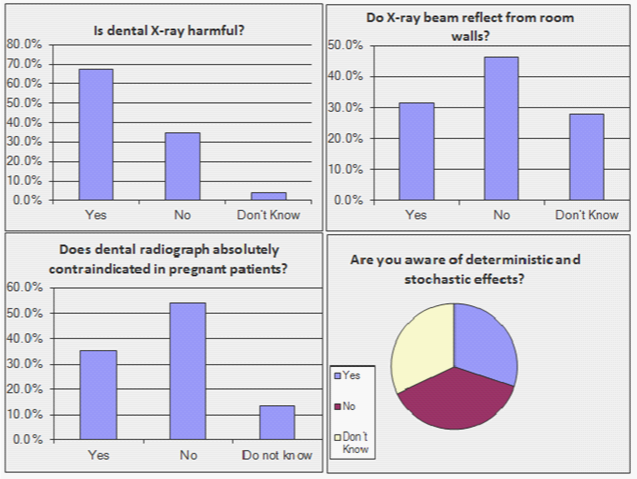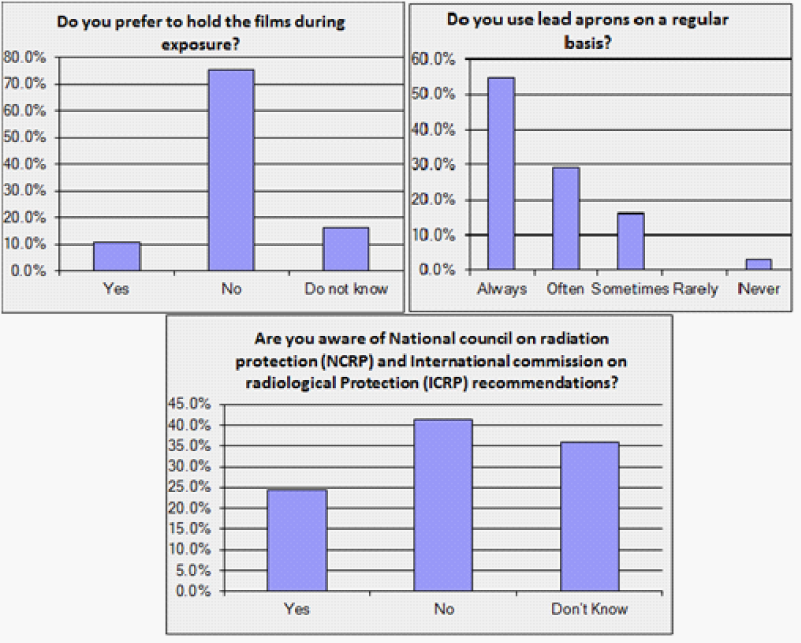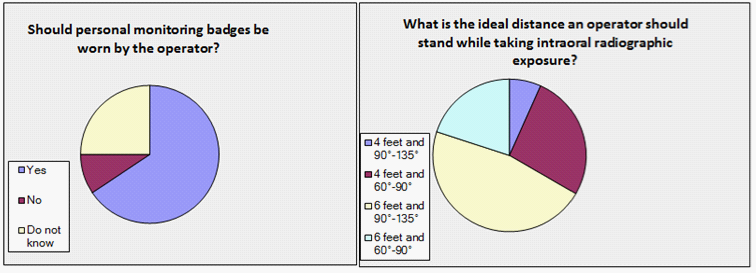Journal of
eISSN: 2373-4345


Research Article Volume 1 Issue 2
1Department of Oral and Basic Sciences, Taibah University School of Dentistry, KSA
2Department of Oral Medicine, Periodontology, Diagnosis and Oral Radiology, Faculty of Dentistry, Ain Shams University, Egypt
3Taibah University School of Dentistry, KSA
Correspondence: Eman Arnout, Oral Radiology, Department of Basic Sciences (female section), Building 3, 2nd floor, Faculty of Dentistry, Taibah University, Madinah, KSA, Oral Radiology, Faculty of Dentistry, Ain- Shams University, Cairo, Egypt, Tel 96537867767
Received: April 16, 2014 | Published: May 26, 2014
Citation: Arnout EA, Jafar A. Awareness of biological hazards and radiation protection techniques of dental imaging- a questionnaire based cross-sectional study among Saudi dental students. J Dent Health Oral Disord Ther. 2014;1(1):23-28. DOI: 10.15406/jdhodt.2014.01.00008
Background: Dental imaging is a helpful aid in the diagnosis of maxillofacial lesions. The dentists have to access benefits against its hazards and be aware of different radiation protection techniques.
Objectives: To assess knowledge, approach and perceptions (KAP) of undergraduate Saudi dental students towards biological hazards of dental x-ray and appropriate radiographic protection techniques. To compare KAP between preclinical and clinical undergraduate students.
Materials and Methods: The study participants included 57 dental undergraduate students (preclinical and clinical years), whose curriculum includes x-ray physics. The information was collected via an online 21 structured multiple choices questionnaires. Statistical analysis: Mann–Whitney U tests at a 5% significance level were used to analyze the difference between the different answers of the 2 groups tested.
Results: Among 57 samples enrolled in the study 42 were in preclinical and 15 were in clinical dental years. Over all correct response was ranged from 22%-76% in the preclinical group & from 33.3%-72.7 in the clinical group. A clear consensus was noticed among the 2 groups evaluated for all questions with insignificant differences between all answers of the survey.
Conclusion: The Knowledge, approach and perception (KAP) level regard to biological hazards effect of x- ray was noted to be low to medium in both groups. Concern the different protection protocols the KAP was found to be ranged from medium to high general knowledge also in the 2 groups. This outcome necessitates continual teaching to ensure maximum safety.
Keywords: knowledge; approach; radiography; protection; hazards; dentists
It is well known that ionizing radiation has biological damaging effects, either affecting the cell directly or indirectly via the production of free radicals. Both lead to DNA damage, including single or double-strand breaks, and or DNA protein cross-links.1 Biological hazards are classified based on occurrence probability into: Non-stochastic and stochastic effect. Non stochastic or deterministic, in which there is determined dose above which the damaging insults start to appear. Stochastic effect, meaning that there is no deterministic dose that could lead to biological damage. High-dose ionizing radiation (x-ray) has both deterministic and stochastic effects. In contrary to lower doses, radiation hazards are primarily stochastic rather than deterministic.2−4
The International Commission on Radiological Protection (ICRP) began to develop the risk/benefit concept since 1977. This concept recommended that all patient exposures must be justified and kept as low as possible.5 So it is a mandatory issue to follow the ALARA principle “As Low as Reasonably Achievable” during dentist routine work.6 However, ALARA principles are not strictly applied in the dental field.7,8 Both dentist and patients are at high risk of stochastic effects as it has no dose threshold. The benefit of disease detection should be weighed against the risk of biological hazards of x- ray.9 Additionally, the amount of radiation exposure from dental radiographs depends on many variables starting from film speed, going through exposure factors, selected technique, collimation and protecting barriers used. The clinical year dental students and interns (junior residential doctors/ house surgeons) should have thorough knowledge towards the biological hazards of x- ray and different protection protocols.10 In spite of the biological hazards of x- ray, enormous benefits were derived from its application in the medical and dental fields. Furthermore, dental imaging produces least radiation dose if compared to medical imaging.11
Undergraduate students will be future dentist who will be at risk of radiation biological hazards during their life. They should be aware of different protection methods against x- ray. The dentist should be aware of different radiation protective methods as well as the daily received radiation dosage. The aim of the present study was to assess knowledge, approach and perceptions (KAP) of biological hazards of dental x- ray and appropriate radiographic protection among Saudi dental students, moreover to compare KAP between preclinical and clinical undergraduate students.
The present study was confirmed by an ethical research committee of Taibah University of dental school. A cross sectional study was performed on 57 undergraduate students (preclinical and clinical) of Saudi Arabia dental schools. KAP assessment was gathered by questionnaire following Prabhat et al.10 with slight modification.
The questionnaire related to biological hazards of dental radiographs and radiation protocol in the form of multiple choices was given to each participant through an online monkey survey. The questions of the questionnaire were divided into three categories.
Statistical analysis
Mann–Whitney U tests at a 5% significance level were used to analyze the difference between the different answers of the 2 groups tested where group 1 was 1st to 3rd year student and group 2 were 4th to 6th year students.
Statistical analysis was performed with IBM® SPSS® (SPSS Inc., IBM Corporation, NY, USA) Statistics Version 21 for Windows.
Ethical consideration
This study was approved by the Research Ethical Committee of Taibah University; a waiver of informed consent was accepted as all the study subjects were unknown.
Responders
Among 66 samples only 57 samples were enrolled in the present study as 9 samples were excluded from the survey as they did not complete Oral Radiology course. The samples included 42 preclinical students and 15 students in clinical dental years, 61.4% of participants were females (Table 1).
Sex |
Group |
Total |
|||
|---|---|---|---|---|---|
Preclinical Group 2nd-3rd Years |
Clinical Group 4th-6th Years |
||||
Count |
Column N (%) |
Count |
Column N (%) |
||
Male |
14 |
34.1 |
8 |
50.0 |
22 |
Female |
27 |
65.9 |
8 |
50.0 |
35 |
Total |
41 |
16 |
57 |
||
Table 1 Classification of the participants based on grouping
KAP results
As regards the biological hazards KAP of dental imaging, the overall correct response ranged from 22%-76% in the preclinical group and from 33.3%-72.7 in the clinical group (Figures 1−4). A clear consensus was noticed among the 2 groups evaluated for all questions without statistical significance different between all answers of the survey (Table 2).




No. |
|
Group |
p-value |
||||
|---|---|---|---|---|---|---|---|
Preclinical Group |
Clinical Group |
||||||
Count |
% |
Count |
% |
||||
1 |
Is dental X-ray harmful? |
Yes |
22 |
52.4 |
10 |
66.7 |
0.505 NS |
No |
17 |
40.5 |
3 |
20.0 |
|||
Don't Know |
3 |
7.1 |
2 |
13.3 |
|||
2 |
Do X-ray beams reflect from room walls? |
Yes |
11 |
26.2 |
5 |
33.3 |
0.922 NS |
No |
21 |
50.0 |
5 |
33.3 |
|||
Don't Know |
10 |
23.8 |
5 |
33.3 |
|||
3 |
Are you aware of National council on radiation protection [NCRP] and International commission on radiological Protection [ICRP] recommendations? |
Yes |
9 |
21.4 |
3 |
20.0 |
0.483 NS |
No |
19 |
45.2 |
5 |
33.3 |
|||
Don't Know |
14 |
33.3 |
7 |
46.7 |
|||
4 |
Are you aware of the usefulness of collimators and filters in dental radiography? |
Yes |
27 |
64.3 |
11 |
73.3 |
0.571 NS |
No |
5 |
11.9 |
1 |
6.7 |
|||
Don't Know |
10 |
23.8 |
3 |
20.0 |
|||
5 |
Are you aware of deterministic and stochastic effects? |
Yes |
11 |
26.2 |
5 |
33.3 |
0.325 NS |
No |
16 |
38.1 |
7 |
46.7 |
|||
Don't Know |
15 |
35.7 |
3 |
20.0 |
|||
6 |
Are you aware of ALARA principle? |
Yes |
9 |
21.4 |
6 |
40.0 |
0.261 NS |
No |
8 |
19.0 |
2 |
13.3 |
|||
Don't Know |
25 |
59.5 |
7 |
46.7 |
|||
7 |
Does digital radiography require less exposure than conventional? |
Yes |
17 |
40.5 |
6 |
40.0 |
0.967 NS |
No |
2 |
4.8 |
1 |
6.7% |
|||
Don't Know |
23 |
54.8 |
8 |
53.3 |
|||
8 |
Does the high speed film require a reduced exposure? |
Yes |
17 |
40.5 |
7 |
46.7 |
0.626 NS |
No |
5 |
11.9 |
2 |
13.3 |
|||
Don't Know |
20 |
47.6 |
6 |
40.0 |
|||
9 |
Do you prefer to hold the films during exposure? |
Yes |
3 |
7.1 |
1 |
6.7 |
0.919 NS |
No |
20 |
47.6 |
7 |
46.7 |
|||
Don't Know |
19 |
45.2 |
7 |
46.7 |
|||
10 |
Do you ask the patient to hold the film with their hand during exposure? |
Yes |
13 |
31.0 |
3 |
20.0 |
0.884 NS |
No |
10 |
23.8 |
6 |
40.0 |
|||
Don't Know |
19 |
45.2 |
6 |
40.0 |
|||
11 |
Does dental radiograph absolutely contraindicated in pregnant patients? |
Yes |
11 |
26.2 |
3 |
20.0 |
0.655 NS |
No |
11 |
26.2 |
7 |
46.7 |
|||
Don't Know |
20 |
47.6 |
5 |
33.3 |
|||
12 |
Should personal monitoring badges be worn by the operator? |
Yes |
15 |
35.7 |
6 |
40.0 |
0.708 NS |
No |
2 |
4.8 |
1 |
6.7 |
|||
Don't Know |
25 |
59.5 |
8 |
53.3 |
|||
13 |
Will you adhere to the radiation protection protocol in the future? |
Yes |
17 |
40.5 |
8 |
53.3 |
0.388 NS |
No |
3 |
7.1 |
1 |
6.7 |
|||
Don't Know |
22 |
52.4 |
6 |
40.0 |
|||
14 |
What is the ideal distance an operator should stand while taking intraoral radiographic exposure? |
4 feet and 90°-135° |
1 |
2.4 |
1 |
6.7 |
0.782 NS |
4 feet and 60°-90° |
8 |
19.0 |
0 |
0.0 |
|||
6 feet and 90°-135° |
12 |
28.6 |
8 |
53.3 |
|||
6 feet and 60°-90° |
4 |
9.5 |
2 |
13.3 |
|||
Don't Know |
17 |
40.5 |
4 |
26.7 |
|||
15 |
Do you use lead aprons on a regular basis? |
Always |
17 |
40.5 |
5 |
33.3 |
0.737 NS |
Often |
4 |
9.5 |
4 |
26.7 |
|||
Sometimes |
3 |
7.1 |
2 |
13.3 |
|||
Rarely |
0 |
0.0 |
0 |
0.0 |
|||
Never |
1 |
2.4 |
0 |
0.0 |
|||
Don't Know |
17 |
40.5 |
4 |
26.7 |
|||
16 |
If never/rarely/ sometimes, why not? |
No availability of apron |
1 |
2.4 |
3 |
20.0 |
0.089 NS |
Due to weight of the apron |
2 |
4.8 |
2 |
13.3 |
|||
Common apron for all |
0 |
0.0 |
0 |
0.0 |
|||
I follow only position rule |
1 |
2.4 |
0 |
0.0 |
|||
I follow only distance rule |
2 |
4.8 |
1 |
6.7 |
|||
Don't know |
36 |
85.7 |
9 |
60.0 |
|||
Table 2 Table showing the questions given to the participant and their response group
Several years ago many studies were directed for the measurement of radiation exposure and had shown the increased occurrence of cancer, abortion, fetus mutagenic changes, cataracts and shortening of life span. Although the previous statement being non-definite and non-applicable for diagnostic dental radiography, it is still acceptable to apply stochastic biological hazards effect.12
Stochastic effects are those effects which follow the probability of occurrence of biological hazard effects, dose independent compared to deterministic effects (i.e. the patient may either shows biological damaging effect or not affected at all, with a minimal radiation exposure). Therefore, the radiation protection protocol should focus on prevention of the deterministic effects occurrence and to reduce the probability of stochastic effects, that is why dentists should be restricted to the “As Low As Reasonably Achievable” ALARA principle concept 6,12,13.
In order to achieve these goals, a thorough knowledge about the biological hazards of x- ray, is a must, in order to do proper radiation protection protocols.
Considering this, in the present study, Undergraduate students (both preclinical and clinical years of bachelor of dental surgery) were selected.
The study showed that among all the groups, a KAP difference to the basic physics and biological damaging effect of x- ray was noted.
Although the results of the present study showed that 52.4% of preclinical group and 66.7% of the clinical group consider x- ray to be harmful, relatively it is still to a low percentage that make them keen in taking precautions against this harm.
A classic question that is usually asked by patients and the technician through your daily work, do X-ray beams reflect from room walls?, 50.0 % of the 1st group and 33.3% of the 2nd group answered NO. This result is dreadful if you think that the entire participant will be one day future dentist who will use dental radiographs in a regular basis.
The results of the present study showed that 42.3% of the 1st group and 27.3% of the 2nd group considering that it is absolutely contraindicated to take dental radiographs for a pregnant female. To simplify this result, about 30- 50 % of the future dentist will dismiss the pregnant women from their clinic, regardless their pregnancy semester, the level of emergency and regardless the different precautions measurement that should be done for these deprived women. In support of our study a previous study was done on 250 general dentists, the author's concluded that the studied population of dentists does not seem to have the sufficient knowledge regarding the diagnostic dental radiation risk during pregnancy.14
When the participants were questioned about their awareness of deterministic and stochastic effect: 26.2% of the 1st group and 33.3% of the 2nd group were yes. This means that about 70% of them were unaware of the probability of occurrence of radiation biological damage, either by under or over estimation of radiation biological hazard effects.
In the present study, 68.0%-72.7% participants claimed that they will adhere to radiation protection protocol in their future clinical practice. From the results of the present study, it is debatable that the future dentists were aware of the radiation protection protocols. In support of our results,10 evaluated undergraduate dental students and interns in their study, their results showed that among 234 samples enrolled in the study, 172 were undergraduates (80 from third year and 92 from the fourth year). The overall correct response was 77.3% and it was noted in descending order from Interns (90.62%), followed by fourth year (83.8%) and third year students (61%).10
From the response obtained through our study, it is obvious that the KAP level of the biological hazards effect of x- ray was low to medium in both groups. The radiation protection principle is to take certain precautions that will minimize exposure to dental professional and patients together with gaining benefits for the patients. Although the level of KAP of the different protection protocols of the both groups was found to be ranged from medium to high general knowledge also in the 2 groups, this outcome necessitates continual teaching to ensure maximum safety. So, it is preferable to do a refresh program at regular intervals at institutional and national level for strict adherence of different radiographic protection regulation protocols.
None.
The authors have no declared potential conflicts of financial interest, relationships and or affiliations relevant to the subject matter or materials discussed in the manuscript.

©2014 Arnout, et al. This is an open access article distributed under the terms of the, which permits unrestricted use, distribution, and build upon your work non-commercially.